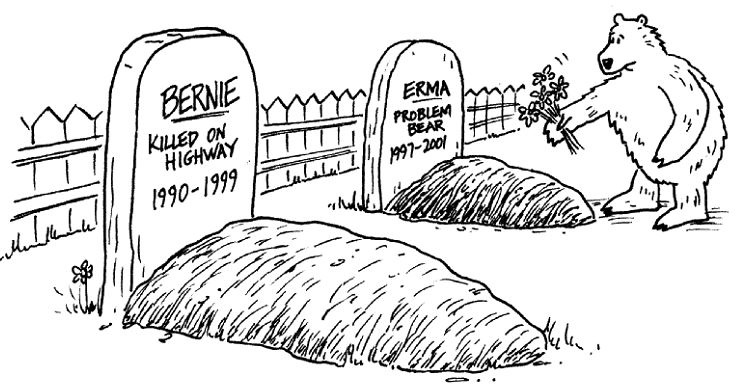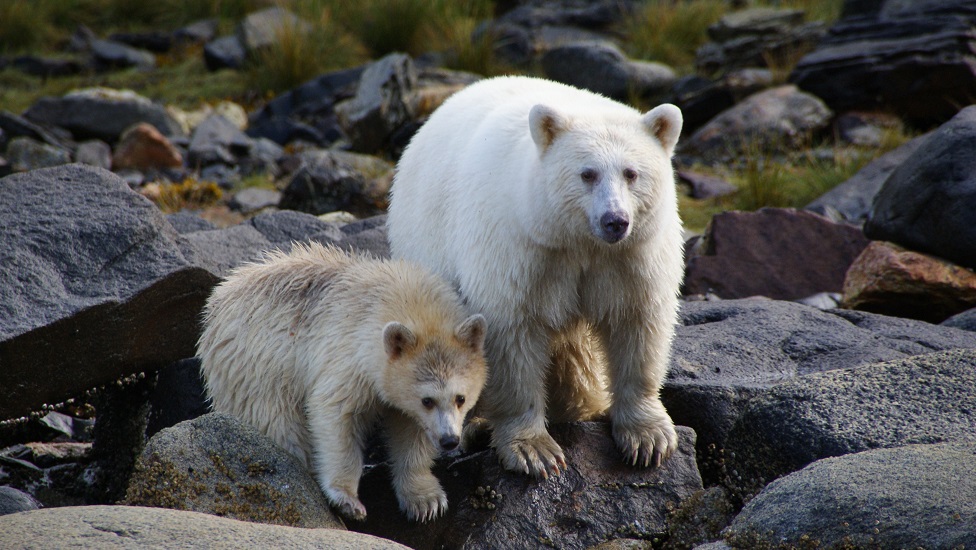Investigate the population dynamics of a real grizzly bear population
PURPOSE
If the number of bear deaths exceeds the bear births in a bear population, then that population will decline. In this activity, students will use data from the Eastern Slopes Grizzly Bear Project to discover the ups and downs of the grizzly bear population in Banff.
GRADE LEVELS
9-12
TIME NEEDED
60-90 minutes

Curriculum LINKS
Science 14 – D. Investigating Matter and Energy in the Environment (STS 2)
Science 20 – D. Changes in Living Systems (G.O. 3)
Biology 20 – B. Ecosystems and Population Change (G.O. 2)
Biology 30 – D. Population and Community Dynamics (G.O. 3)
MATERIALS NEEDED
Download: Student worksheet (pdf)
Download: Teacher solution sheet (pdf)
Pencil crayons, calculators
Key Words – birth rate, death rate, reproductive rate, recording and analyzing data, population size, carrying capacity, natality, mortality, immigration, emigration, r- and K-selected reproductive strategies
Background
Introduce the concept of population dynamics. Over a long period of time, the number of bears in a population is affected not only by the number of births during that period, but also by the number of deaths. To maintain a stable population of bears over time in an ecosystem, wildlife managers must ensure that the birth rate equals or exceeds the death rate!
Students will be using data from the Eastern Slopes Grizzly Bear Project: Gibeau, M., S. Herrero, J. L. Kansas, B. Benn. 1996. Grizzly bear population and habitat status in Banff National Park: A report to the Banff Bow Valley Task Force. University of Calgary, AB. 62pp.
Instructions
1: Define the words mortality (death rate) and natality (birth rate) for the class. Grizzly bears have a very low birth rate and are among the least reproductive large mammals in North America. The mortality rate is a very important factor for determining bear populations! Review the terms r-selected and k-selected species.
K-selected species usually live near the carrying capacity of their environment. Their numbers depend on the availability of resources. In other words, they are a density dependent species. Food availability, habitat quality/security are resources that control population size. K-selected species have long maturation time, breeding relatively late in life, a long lifespan, producing relatively few offspring, large newborn offspring, low mortality rates of young, and extensive parental care.
R-selected species are the opposite. They are very opportunistic. R-selected species have short maturation times, breed at a young age, have a short lifespan, produce many, small offspring quickly, high mortality rates of young, and nonexistent parental care.
2: Ask the students to brainstorm possible causes for grizzly bear mortalities in Banff National Park. Have them rank these in order of most significant to the least significant. Compare the students’ list with the statistics on the following page. In Banff National Park, habituated bears die more then any other cause. Habituated bears are bears who have lost their natural fear of humans. These bears may have been fed by humans, or have encountered garbage or food left behind by careless campers. Habituated bears often are shot by conservation officers or wardens if they pose a threat to human safety.
Habituation: When a bear becomes used to and loses its natural wariness of humans and human things (highways, cars, photographers). Positive reinforcement and rewards play a role (feeding bears, careless storage of food/garbage).
3: Distribute worksheets to the class and have students fill in the table titled, Grizzly Bear Mortalities in Banff National Park. A teacher solution is also provided. Have students fill in the blanks by calculating:
- the totals for each type of mortality
- the average number of mortalities per 5 year period for each type
- the combined total average number of mortalities
4: Have the students complete a histogram (plotting the number of deaths per year versus the five year periods) to represent the mortalities for each five-year period. Have them divide each bar into portions to represent the causes of mortality.
Discussion
Which part of the histogram surprises your class the most? Why?
The following might be useful in answering students’ questions:
- Railroad: Bears are often attracted to the railroad due to spilled grain along the tracks and are hit by trains.
- Highway: Vegetation cleared along roadsides creates false bear habitat: fresh shoots and buffalo berries grow in these cleared areas. Feeding near and crossing highways is very dangerous for bears.
- Habituation: Many bears are attracted to areas near development because of the great smelling garbage that humans create. As a result, these bears become less wary of humans. Unfortunately, a close encounter with humans usually means death.
Are the mortality numbers completely accurate? What are the ‘sources of error’ that are possible?
Fifty percent of all grizzly bear deaths are unknown! This is because:
- Bears who die of natural causes may never be found; bears included in the population may die outside of the park, or move out of the park
- Hunting occurs outside of BNP, legally and illegally
- Wildlife managers are realizing that poaching may be a more serious threat than previously thought (the many roads into the backcountry allow greater human access)
The researchers for the Eastern Slopes Grizzly Bear Project found that the majority of the bears dying in Banff National Park are females. Ask students why this might be a problem for grizzly bear populations.
Biologists believe that females are far more important than males. Females are the reproductive “engines” of the bear populations and are key to maintaining stable populations – so long as there are some males around to help out!
Some environmentalists and park managers claim that we don’t have a bear problem we have a human problem.” Ask students if they agree. What do they think a “problem bear” is?
This question is one that challenges our assumptions and perceptions regarding bears. A problem bear is one that, through its aggressive or non-conforming behaviour, breaks some of the rules we have set out for how ‘good bears’ ought to behave. Today, we refer to problem bears as habituated bears. Most conflicts between humans and bears are due to an error made by people in the park.
Biologists feel that large, well-protected areas should serve as a source of grizzly bears by creating an excess of bears every year. These excess bears would disperse to less protected areas. Is Banff National Park a ‘source’ or a ‘sink’ for grizzlies?
Given the known natality and mortality rates for Banff, it should be a source of grizzly bears. However, if the actual mortality rate is higher than the natality rate, then Banff would be a sink.
What are suggestions for reaching a stable, or better yet, a growing number of grizzlies?
Slower speed limits on the highways, restrictions on human access to some areas, travelling responsibly in bear country, importing bears from other areas (costly and long-term).
More Bring Nature Home for Teachers
Bring Nature Home is our online database of tried-and-tested CPAWS Southern Alberta activities! Here are some ways that you can bring nature home (or to the classroom) today!

Birding 101

How do species become extinct?

